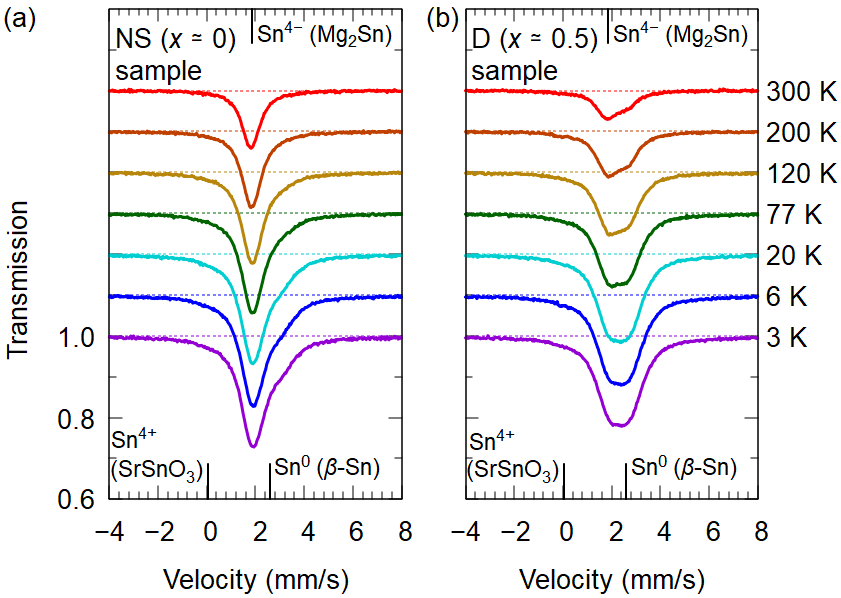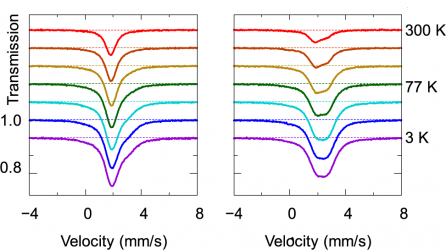逆ペロブスカイト酸化物であるSr3SnOでは、(Sr2+)3Sn4−O2−というように、スズが陰イオン状態になっていると予想されています。金属であるスズは通常ではSn2+やSn4+という陽イオンになるので、酸化数の正負が「逆」になっているSn4−という陰イオン状態は異常であり、もし本当にSn4−が存在するならば酸化物ではたいへん珍しいです。ところが、実際に物質中でスズがいくつ電子を持っているか、実験的には調べられていませんでした。
我々はスズのイオン状態を調べるためにメスバウアー効果を利用しました。 メスバウアー分光法では、物質がどの波長のガンマ線を吸収するか調べることでスズの状態を知ることができます。(ガンマ線とは紫外線よりももっと波長が短い光です。)その結果、Sr3SnOに含まれるスズが確かにSn4−になっていることを明らかにしました(図)。さらに、ストロンチウムが少ないSr3−xSnOの内部では、ストロンチウム欠損(3−xのxの部分)に隣接しているスズはSn4−とはさらに異なったイオン状態であることも発見しました。酸化物でスズが陰イオンになっているのが観測されたのは初めての成果です。この発見をとおして、異常な金属陰イオンを持つ逆ペロブスカイト酸化物にさらなる注目が集まると期待できます。
本研究は京都大学複合原子力科学研究所の瀬戸教授のグループとの共同研究です。論文情報は下に記載してありますが、研究者でない方などのPhysical Review B誌を購読されていない方は京都大学学術情報リポジトリ(KURENAI)からも論文をご覧いただけます。
 Sr3SnO(左)とSr3−xSnO(右)のメスバウアースペクトル。横軸がガンマ線のエネルギーで、縦軸が透過率。Mg2Snと同じ位置でガンマ線の吸収が起こっていることから、Sr3SnOにSn4−が含まれていることが分かる。さらにSr3−xSnOでは吸収の形が変化することから、異なるイオン状態のスズが含まれていると分かる。
Sr3SnO(左)とSr3−xSnO(右)のメスバウアースペクトル。横軸がガンマ線のエネルギーで、縦軸が透過率。Mg2Snと同じ位置でガンマ線の吸収が起こっていることから、Sr3SnOにSn4−が含まれていることが分かる。さらにSr3−xSnOでは吸収の形が変化することから、異なるイオン状態のスズが含まれていると分かる。
論文情報
Ikeda, A; Koibuchi, S; Kitao, S; Oudah, M; Yonezawa, S; Seto, M; Maeno, Y
Negative ionic states of tin in the oxide superconductor Sr3-xSnO revealed by Mössbauer spectroscopy Journal Article
In: Physical Review B, vol. 10, no. 24, pp. 245145, 2019.
@article{Ikeda2019,
title = {Negative ionic states of tin in the oxide superconductor Sr_{3-x}SnO revealed by Mössbauer spectroscopy},
author = {A Ikeda and S Koibuchi and S Kitao and M Oudah and S Yonezawa and M Seto and Y Maeno},
url = {http://hdl.handle.net/2433/250418
https://arxiv.org/abs/1911.12934},
doi = {10.1103/PhysRevB.100.245145},
year = {2019},
date = {2019-12-24},
journal = {Physical Review B},
volume = {10},
number = {24},
pages = {245145},
abstract = {We report the temperature variation of the Sn119-Mössbauer spectra of the antiperovskite (inverse perovskite) oxide superconductor Sr3-xSnO. Both superconductive (Sr deficient) and nonsuperconductive (nearly stoichiometric) samples exhibit major γ-ray absorption with an isomer shift similar to that of Mg2Sn. This fact shows that Sr3-xSnO contains the metallic anion Sn4-, which is rare, especially among oxides. In both samples, we observed another γ-ray absorption with a larger isomer shift, indicating that there is another ionic state of Sn with a higher oxidation number. The temperature dependence of the absorption intensities reveals that the Sn ions exhibiting larger isomer shifts have a lower energy of the local vibration. The larger isomer shift and lower vibration energy are consistent with the values estimated from the first-principles calculations for hypothetical structures with various Sr-deficiency arrangements. Therefore, we conclude that the additional γ-ray absorptions originate from the Sn atoms neighboring the Sr deficiency. © 2019 American Physical Society.},
keywords = {},
pubstate = {published},
tppubtype = {article}
}
We report the temperature variation of the Sn119-Mössbauer spectra of the antiperovskite (inverse perovskite) oxide superconductor Sr3-xSnO. Both superconductive (Sr deficient) and nonsuperconductive (nearly stoichiometric) samples exhibit major γ-ray absorption with an isomer shift similar to that of Mg2Sn. This fact shows that Sr3-xSnO contains the metallic anion Sn4-, which is rare, especially among oxides. In both samples, we observed another γ-ray absorption with a larger isomer shift, indicating that there is another ionic state of Sn with a higher oxidation number. The temperature dependence of the absorption intensities reveals that the Sn ions exhibiting larger isomer shifts have a lower energy of the local vibration. The larger isomer shift and lower vibration energy are consistent with the values estimated from the first-principles calculations for hypothetical structures with various Sr-deficiency arrangements. Therefore, we conclude that the additional γ-ray absorptions originate from the Sn atoms neighboring the Sr deficiency. © 2019 American Physical Society.


![]()
